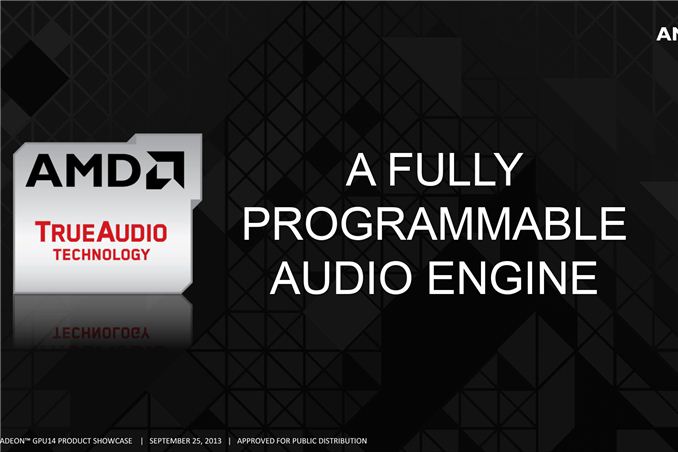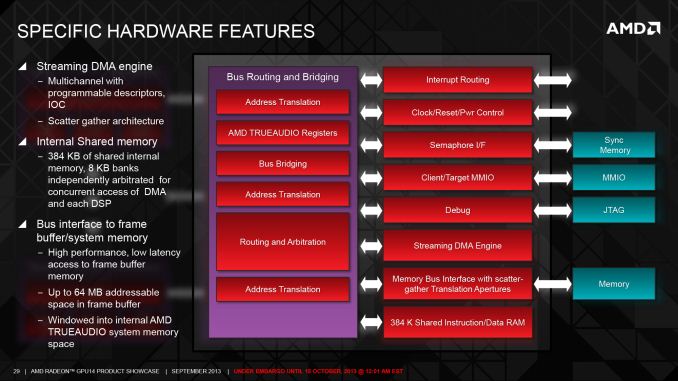PS4 Spec Update: Audio DSP Is Based On AMD’s TrueAudio
by Ryan Smith on November 13, 2013 3:07 PM EST- Posted in
- GPUs
- AMD
- Audio
- PlayStation
- TrueAudio

Continuing our coverage of AMD’s APU13 conference, one of this morning’s keynotes has been from Sony’s VP of Research & Development in North America, Dominic Mallinson. Most of Dominic’s presentation was a recap of the PS4 thus far – including some detail in why Sony went with an AMD APU for the console – but Dominic did throw in one more piece of information on the PS4’s specifications that we haven’t heard before. Specifically, the PS4’s audio DSP is based on AMD’s TrueAudio technology.
Briefly, from a console-centric view this isn’t of great surprise. We’ve had every reason to believe that the PS4’s audio DSP would have similar capabilities to TrueAudio given the features and low die space cost of today’s audio DSPs, coupled with Sony’s previous comments on the matter. So from that perspective this isn’t a significant revelation as far as the PS4’s audio capabilities are concerned, but we do finally have a bit more detail on the underlying hardware powering it.
But from a PC perspective however, this is going to be more important and unexpected news. At this time we don’t know what the underlying API is like – AMD hasn’t even released the TrueAudio PC API yet – but the shared hardware is going to be a big deal for both AMD’s CPUs and APUs. One of the challenges we discussed as facing TrueAudio is developer adoption; AMD has to convince developers to take the time to program for TrueAudio along with more traditional CPU sound engines. AMD has been working with audio middleware developers to help bootstrap TrueAudio adoption, but today’s announcement would take that one step further.
PS4 utilizing TrueAudio means there will be at least some level of audio engine portability between the PS4 and current generation AMD products. To that end if developers can write high quality audio engines on the PS4 thanks to the presence of the dedicated audio DSP, and then take that audio engine and bring it to the PC to run on GPU/APU TrueAudio DSPs, then that provides a further avenue for bootstrapping TrueAudio usage in games. So much like Mantle in the graphics space, a shared console connection for TrueAudio in the audio space would allow for AMD to leverage their console connection to both allow better/easier porting from consoles, and to achieve the critical mass necessary to make tapping these low-level hardware features viable and worthwhile for a wider pool of developers.
That said, AMD isn’t promoting TrueAudio as a console porting solution right now like they have been Mantle, but the potential is there if AMD and developers seek to exploit it. Which if nothing else makes TrueAudio all the more worth keeping an eye on over the next year, as solving the bootstrap/adoption issue will be a critical factor in the technology’s success. On that note, according to AMD’s latest schedule Thief is still expected to be the PC TrueAudio launch title, so we should be getting to see the first fruits of AMD’s labor here in February.


















43 Comments
View All Comments
nathanddrews - Wednesday, November 13, 2013 - link
I wouldn't go that far...cwolf78 - Thursday, November 14, 2013 - link
That's what she said.Penti - Wednesday, November 13, 2013 - link
Basically it goes this far, a few developers will update their bought in third party middleware audio engine and gain some performance due to lower cpu usage, but every audio-effect they make will still need to work without a dsp. It's simply not the same API's on the consoles, they will need for their audio middleware to support the consoles specifically with the consoles own API's, Mantle isn't the same as the console api's either. The consoles uses their own api's and there is no need to abstract a low-level API which is feature compatible with HLSL (tools can mostly translate between say PSSL and HLSL, or GLSL or Cg and will be able to do the same with Mantle's native shader language when such tools are written many big gaming engines also implement their own shading languages so they will always have to rewrite the implementation and backend of it per device/platform for it to work great, the content creators doesn't really have to bother with that even if they do use shader code as there is a team of core game engine developers or porters working with that) with a low-level API which is feature compatible with HLSL such as Mantle. It's easier to actually port the game engine than try to support Windows games with a Mantle-wrapper. Compatible means you can do the same type of operations and exposes the same features (or more) that's in the hardware/driver as Cg, HLSL or GLSL not that it's API-compatible. Just because you can do something with mantle doesn't really mean you can easily do it with PSSL and GNM/GNMX, or wise versa when it comes to the PC and D3D/HLSL or Mantle optimized versions derived from that D3D/HLSL code-base, here GNM, GNMX and PSSL is the low-level, high-level and shader graphics API's on the PS4. You still have to figure out how the drivers and hardware work on each platform when your optimizing especially on the consoles and it's still pretty different than to work on a PC, and now has pretty high demands when the target is basically solid 60 fps on every game. You can't just trow stuff from main memory to gpu and back and around however you feel like and have to work around built in bottlenecks in each implementation of something and when working with different systems. An API doesn't really fix that, it's just one tool among others and is still dependent on each different implementation, as well as the limits in hardware/software.djscrew - Thursday, November 14, 2013 - link
You sound like you know what you're talking about but your wall didn't make much sense to me.psuedonymous - Thursday, November 14, 2013 - link
tl;dr version:Game developers don't write things to work with Trueaudio, they work with middleware. those middleware developers will add Trueaudio capability (and hopefully spur additions to their middleware to take advantage of and new Trueaudio capabilities) and support for whatever the PS4 variant of Trueaudio is. Thus, developers using this middleware will get the benefits of Trueaudio when on systems using it, the benefit of the Trueaudio-derived PS4 API when running on that, and the benefits of stuff-that-does-the-same-things-as-Trueaudio-but-on-the-CPU when on systems that don't use Trueaudio.
psuedonymous - Thursday, November 14, 2013 - link
Actually, that should be 'most developers', and 'almost all multi-platform developers'. Game devs focused on one platform will probably have the time and inclination to work directly with the lowest level APIs available to squeeze every last bit for performance out of the console, but devs who want/need to have their game available across multiple platforms are more likely to hand off handling audio to a separate bit of middleware that talks to all the platforms they're running on to save having to write the audio interface several times over.Penti - Thursday, November 14, 2013 - link
But they aren't really looking for a wrapper so they can use Mantle everywhere either though. Game content devs work against their own middleware and game engines that some branch of their company create or buy from a third party, and have tools on that side, while the porters or game engine devs is concerned about the low level stuff and optimizations, those will be different on different platforms not matter what so what API it is doesn't really matter that much, getting performance and bottlenecks worked out is probably what takes the longest time, as well as all the platform and implementation specific bugs. The tools for optimization and performance tracking will also be different on each platform. In the end it's up to the middleware (which you have several pieces of say audio engine, physics engine etc) or game engine to support the same features on all those platforms, it's not just like you have to recompile to run on X1 neither. Neither is a OpenGL game on OS X the same thing as one on Windows. There's always work to be done and some differences in API or implementation. You will have to do optimizations on both.TheJian - Friday, November 15, 2013 - link
Let me shorten even more: devs don't do free extra work for niche hardware solutions ;) Translation:Mantle/True-Audio are going nowhere, much like Glide. A few paid titles and that's it. The rest of us still have to be written for anyway, so you'll just write for US unless AMD pays you.Wolfpup - Tuesday, November 26, 2013 - link
The point is though that with PS4 using the same basic thing, there's a shot that most current gen games that hit PC will also support trueaudio.TheJian - Friday, November 15, 2013 - link
Audio I have already...Let me know when AMD catches the Intel CPU portion, maybe we can talk about me purchasing an AMD cpu then ;) The list of games where Intel completely dominates AMD in CPU is very long. It is NOT just Civ5 like this site would like you to believe as I clearly pointed out in the 1440p articles which ridiculously recommends an A8-5600 for ALL SINGLE GPU cards...Laughable. But then I expect that from a site with it's own AMD PORTAL, and NO NV love ;) Ryan keeps pushing the pipe dream that Mantle has a console connection. It's NOT TRUE.